Author: Lan Xi
Manus dominated the screen for a day, from its overnight fame to the difficulty of getting a code in the middle, to the questioning of its publicity and promotion. In the whole process, FOMO emotions and intuitive vigilance were intertwined, which is a very interesting communication sample.
In fact, the AI industry has been an "explosion-driven" information model in the past few years. Those who understand it have already disenchanted it, but those who don't understand it will still be surprised.But to be honest, with such explosions every day, there will be some real explosions mixed in.
And my evaluation of Manus is that it is indeed one of the truly explosive ones, and it can be called the DeepSeek moment of the AI Agent industry, but there is a patch, which I will add at the end.
First, let's take a look at a demonstration effect of Manus:
Let it develop a text interactive game, where you can play the role of Google's CEO. By experiencing important decisions in the company's history, you can not only have fun in the game, but also understand the company's culture.
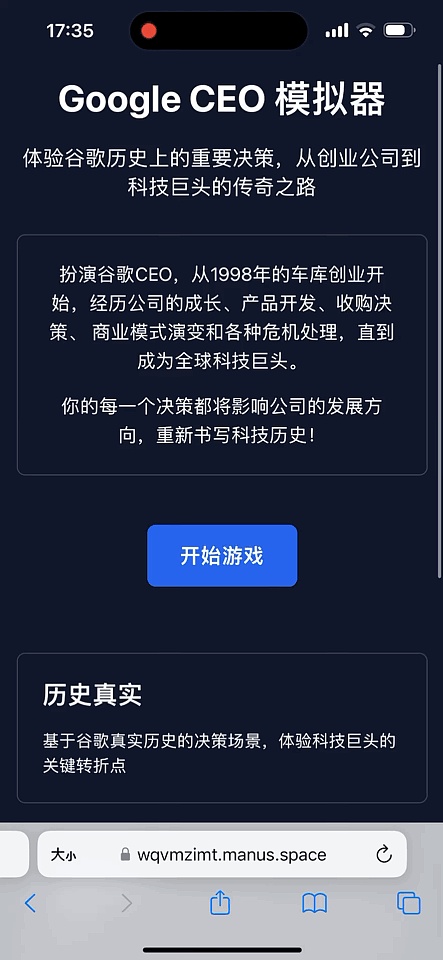
It took almost an hour for Manus to develop the web game of Google CEO Simulator, which is very complete. Click to start the game, and you will be asked to choose the difficulty. Then you will face every transformation node in Google's development history. Your choice will determine the change of the company's resources and affect the final game ending.
In one hour, using one sentence, to make a game, this is the ability of AI Agent.
It is different from traditional conversational AI. It no longer just provides answers at the information level, but can operate computers to complete more specific work tasks, including but not limited to writing programs, making web pages, compiling reports, screening resumes, etc. It can completely solve various difficulties encountered in the process and deliver work results independently. Of course, there are exceptions, which we will talk about later.
Currently, there are not many mainstream AI Agent services, and they are generally very expensive. For example, ChatGPT Operator requires a Pro membership of $200 a month to use, and Devin, an AI engineer product that focuses on the programming market, costs $500 a month.
The developer of Manus is the Chinese large model team Monica. It is currently in the free testing stage. The cost of a single task has been reduced to $2, which is 1/10 of OpenAI. At the same time, it has surpassed OpenAI in the benchmark rankings and won the world's strongest.
After I got the invitation code, I exhausted Manus's daily computing resources within a few hours. I was really excited and the effect was amazing.
Let me show you some actual test cases:
First, I asked it to help me make a personal homepage in the Linktree style. Manus divided this task into 8 steps. It first collected my information from the entire network, including my links and representative works on various platforms, and then started to write web page code based on the Linktree design style. Half an hour later, it delivered such a work to me.
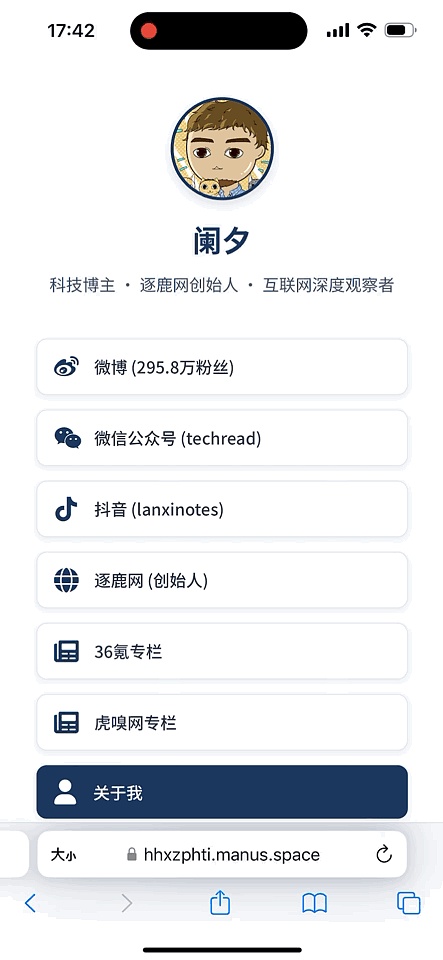
It's simple, but it meets the requirements perfectly. There are no problems with the interaction. It has the copy effect of Sharingan level. If you want to make it more beautiful, you can continue to write prompts for it to modify.
The second test was that I used Manus to help an engineer group member solve a practical problem. The Atlas robot arm he was responsible for maintaining in the factory had a small problem. If he went to after-sales service, it would cost several thousand yuan. It would be better to find a way to make up for it himself. He was too lazy to read the document, so he directly gave me a paragraph and asked Manus to see how to deal with it.
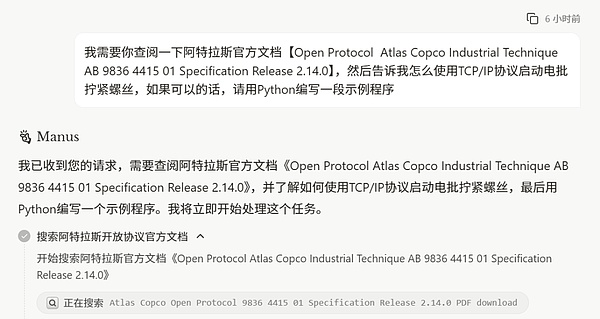
Note that in theory, ordinary conversational AI can also meet this requirement, but it will require more interactive processes, such as you have to feed it documents and get answers step by step, but Manus does not need these. It will go to the Atlas official website to download the documents by itself, read them, find the key content needed to solve the problem, analyze them carefully, and create programs. I sent the final code to a friend. It has some minor flaws, but it is completely usable after manual modification, which directly saves one after-sales call.
The third test was proposed by my Weibo readers, asking Manus to do a minimalist chronicle of a country. I added the requirements of comic table selection and web design. The color matching of the final delivered work is a bit difficult to stretch - AI has no aesthetics, this point must be repeatedly emphasized - but at this time Manus's server has been down and cannot be modified for the time being, so I will just show the semi-finished product.

You can see that Manus divides the history of Britain into 10 different eras, and draws SVG pictures based on the style of the era, and finally presents them on the HTML web page. It can be said to be a model room for human-computer collaboration. Whether it is used as an extracurricular teaching plan or a work preview, it has an extremely convenient threshold for getting started.
The last case is that I asked Manus to make a Candy Crush game, but the icons had to use the characters of Genshin Impact. It first began to study the game mechanism and implementation methods of Candy Crush, and then tried to collect the picture materials of Genshin Impact. At this time, an exception occurred. It issued a takeover request for the first time. The reason was also speechless. Its operating logic was blocked by a network disk, and it was impossible to register an account, so it could not download resources, and wanted me to help it download.
It seems that no matter how powerful the AI is, it will be blocked by the members of the network disk.
Based on the principle of letting the AI Agent complete the work independently as much as possible, I did not do this, but slightly changed the requirements and let Manus use the logo of the technology company as the game icon. Because the copyright-free SVG materials are all over the Internet, there is no problem running Manus now. I quickly completed a point-based elimination game, which was smooth to play.
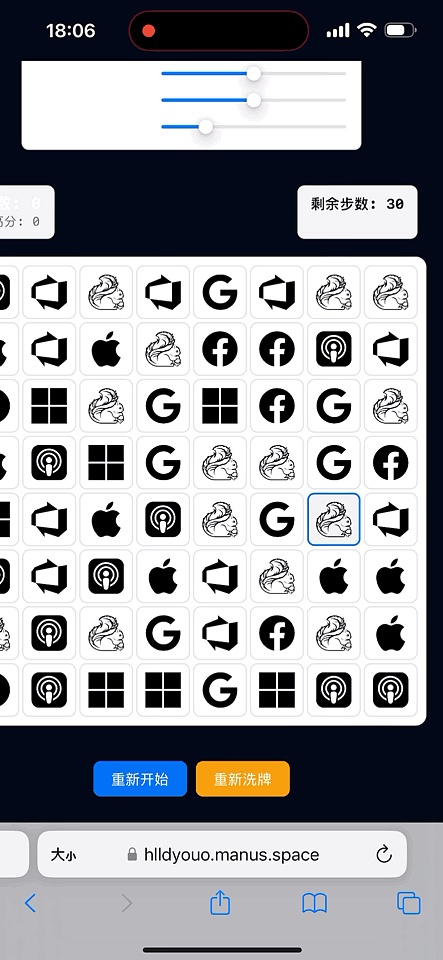
However, it can be seen that when solving such relatively complex problems, Manus still lacks some details, which is also related to the lack of human (me) participation. For example, the adaptation problem of the screen needs to be given more instructions. Manus's modification response is not slow, but because of the same server downtime, this task has not been further improved for the time being.
I think these few actual examples can clearly show the capabilities and shortcomings of AI Agent at this stage. Manus is no longer a product that can only operate a browser. It has a sandbox environment and can test itself before completing the work. It can be delivered after acceptance, but it is also limited to the data boundary of the Internet. If there are not enough resources on the network, it has no way to produce resources to be self-sufficient.
I also did some essay-based tests, which can also be used to compare the characteristics of AI Agent:
For example, I asked Manus to give her operating skills based on the 10 most popular videos of Hoshimi-ya (game character) on Bilibili.

Manus really watched all 10 videos - it took more than an hour - and then refined the essays of each UP master into the materials I wanted, and it was quite accurate. If the same task is given to a large networked model, although it can be completed, the probability of hallucination is very high, and it is not as reliable as AI Agent in terms of "honesty".
For another example, I asked Manus to study the arbitrage possibilities of PolyMarket. Although I did have a slight expectation and wanted to get an investment guide that would make sure I would make a profit - don't laugh - Manus did his homework diligently and listed four arbitrage opportunities, so that as long as I saw eligible projects appear on PolyMarket, I could bet according to the rules without thinking.
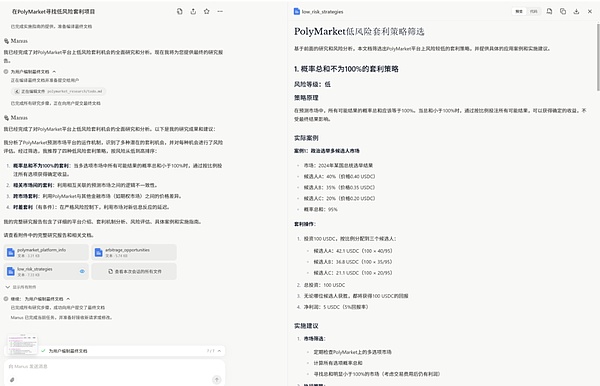
From the playback, Manus always started with the most basic information, first understanding what PolyMarket is, then analyzing the gameplay of the prediction market, and then building a risk strategy based on the platform rules. He is a standard intern, hardworking, down-to-earth and durable.
By the way, the playback design is also one of the highlights of Manus in my opinion. It is a bit like the choice of reasoning model to expose the chain of thinking. In many cases, the thinking process of AI is more inspiring than the answer supply. Every task of Manus has a playback function and can be shared. The means it shows in solving problems can be regarded as another form of intelligent assets, which can play the role of human teacher.
So, in my opinion, Manus is the DeepSeek moment of the AI Agent industry. A patch is needed here, which is the DeepSeek-V2 moment. In May 2024, DeepSeek open-sourced the V2 version of the model. This was the first time it went out of the circle because the price was very cheap, but because the model itself was average, many people at that time just thought that DeepSeek was going to start a price war. They were surprised but did not take it seriously, and the popularity did not last too long.
It was not until the successive release of DeepSeek-V3 and R1 that everyone realized that things were completely different. Overnight, the cost logic of the entire large model market was overturned.
Initially, no one cared about this disaster. It was just a wildfire, a drought, the extinction of a species, the disappearance of a city, until this disaster was closely related to everyone. ——"The Wandering Earth"
What I mean is that the development of AI technology is continuous, and on this ups and downs curve, the signal strength of each time determines the depth of the subsequent breakthrough, just like DeepSeek would not have V3 without V2, let alone R1. My view on Manus has not changed. At the historical turning point of bringing AI Agent services from professional scenarios to general scenarios, it is the founding brand of the school.
From the use case point of view, as an AI Agent, it is very powerful and has a high proficiency in disassembling tasks. The observation of CoA (chain of agents) feels very similar to that of CoT (chain of thinking), and it can "see" AI evaluate and seek the best solution in multiple solutions.
In theory, it should have a large number of CoAs built in to take over, just like reasoning models such as DeepSeek, which will only be launched to the mass market after digesting a sufficient amount of CoT in advance, covering mainstream needs as much as possible, as can be seen from the Use Case on the official website.
 Catherine
Catherine











